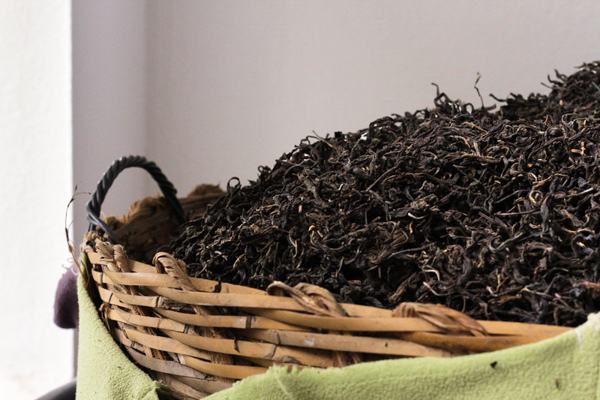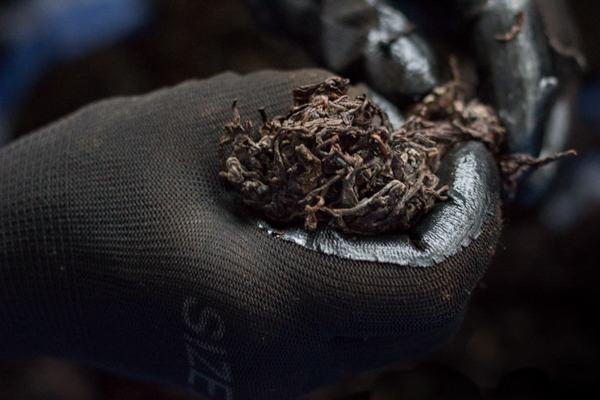Craft ripe pu-erh. Interview with Tea Mail
Andrey Simonov from the "Tea Mail" project (Minsk) offered TeaSide to give an interview about our own production technology of Shu pu-erh, I am developing since 2013. The interview turned out to be unexpectedly detailed; however, I will gladly answer additional questions in the comments, if any.
TM: How long have you been thinking of an experiment to produce shu pu-erhs?
Since I discovered Thai pu-erhs and found out that there are not enough ripe (shou) pu-erhs in Thailand I started to think of producing mine.
Actually, various Internet articles and videos pushed me to those experiments. As they say, Chinese technology doesn’t assume producing ripe pu-erh out of less than 3 tons of material. Allegedly, a smaller amount of material will not heat up to the desired temperature and, in general, the fermentation process will go wrong. I’ve been thinking why so.
That time, I thought the vertical pressure of the big mass is important. But then on photos, I saw the tea spread out over a large area in an only one-meter thick layer. To make a one-meter high heap, 3 tons are not required. Moreover, as you know, Liu Bao cha has been done for hundreds of years and its taste is very close to ripe pu-erh. To make it Chinese use just 20-30 kilos of raw materials, but fermentation takes at least one and a half years.
That is how the idea to make ripe pu-erh tea in a basket was born. With the only difference - a short fermentation period, I did not see any serious physical obstacles to this.

Before start. After fermentation, tea looses about 10% of its initial weight.
TM: What prevented you from starting? What was you afraid of?
At first, I was afraid that the raw materials wouldn’t warm up to the minimum required 50 degrees. As it turned out later, this problem does not arise at all. To warm up the pile, a small amount of leaves like five kilograms is already enough. There were other difficulties. For example, when you work with a small volume, it is difficult to keep its humidity within certain limits during the entire fermentation period. A small pile dries very quickly. Adding water and stirring frequently drops the temperature. The over-watering leads to speed-up processes inside the basket.

The basket just after watering and stirring. The temperature rises up quickly.
But in general, there was also nothing to be afraid of, because in the first experiments I’ve been risking a small amount of the cheapest material that I could find.
TM: What preparations did you do for production? How did you choose the time, technology, and mao cha? Where do you search for information?
There was no special preparation. I did not choose a special time.
I asked everyone who visited China and watched the process with his own eyes about the process. We corresponded with Scott from "Yunnan sourcing". We tried to get a general picture, made some hypotheses.
The problem was that in different places of China, technologists work a little differently. Some cover the heap tightly with several layers of warm sheets. Others are just throwing one layer of synthetic burlap and that's all. There were a lot of questions: how much water to pour and how often, how often to stir, what kind of mold should appear and at what stages.

After watering, I took the tea out of the basket for thorough stirring.
These were only the very first questions. Gradually, they became more complicated and still continue to become more complicated. For three years of relatively successful work, the number of questions has only increased, but they have become more particular and tricky.
Right now, I’m just making new batches, gradually shifting the numbers, trying to find the right combination. You need to take into account a lot of factors - texture and consistency of the original mao cha, it's mass, the season of fermentation and much more. For example, for a long time, I’ve been afraid to use young and expensive material, as I understood it could behave differently and all our producing markers could not fit.

Breaking lumps
TM: How was it going on in reality?
Well, the very first experiment went to fertilize the nearest flowers. It was not clear what was happening to the material, what to expect from it at different stages, or what to pay attention to. I took a pause and began to ask again. Gradually, the most important moments cleared up, and I put other tea in a basket for fermentation, more serious and suitable for ripe pu-erh, to cut off at least the material factor.
The main difficulty was that even knowing some technological indicators and markers from the Chinese, I had to change them and adapt to micro-sizes.
The second batch turned out to be very similar to shu by appearance, but it was absolutely undrinkable. Nobody knew what to do with it. We did not want just to throw our work out, but there was no hope for this tea either. So it was just left it in a box. I took a pause again and switched to other tea. Several times during the next 6 months, someone tried to get rid of it, but something stopped us every time. Then, one day, this box caught someone’s eyes again and to clear our conscience before I finally threw it away, I decided to try it again. And, what a miracle, almost all the unpleasant notes have left! The tea turned out to be a quite decent shu pu-erh. It simply has rested. Not perfect, of course, but not repulsive. Thus, it became clear that the initial hypotheses, in common, proved to be correct.

With this tea, everything goes right.
After this first successful experiment, I started to produce batch by batch, working with the same material. Then somehow tried the other, but it turned out something completely strange. The tea was unbrewable; the infusion didn’t turn out, neither in color nor in taste. Somewhere, I made a mistake, and the fermentation went wrong. This also happens in Menghai, as far as I know.
TM: Did the expectations justify themselves? What is the result?
A month ago, I opened a pack of ripe pu-erh from that first successful batch. Someone packed a sample before and forgot about it. This time the taste was whiskey. Not just woody, but exactly barrel whiskey, with no extraneous or unpleasant notes, and without alcohol. Very interesting taste profile, probably even exquisite. In that bag also was a piece of pu-erh resin (cha gao) - who knows whether this affected. It is a pity that I don’t have that shou any more.
Now I can say that the expectations have justified themselves much more than I could have guessed. We take any material and work, mainly, on the purity of taste and on the taste notes needed. There is a vast field for activity: one step away and the taste changes, mostly not quite where you would like it to go.

Final drying
TM: What do the numbers in the names mean? What exactly, in details, were the differences in the production of your three shu pu-erhs?
The names are not tricky. The first pair of digits is the number of the garden, where I take the mao cha from. And the second - the number of the batch which technological parameters I began to use further for this material. In fact, there are enough changes already for new numbers, but I don’t hurry to rename because buyers get used to these numbers.
In Shu numbered 0302, I use the material with a small number of buds. But the advantage of this mao cha is that it is from 2010, so it’s already ripened. It is easier to stir, the leaves do not stick together, and it keeps the water well. Sheng pu-erh from this material enjoys a decent demand, due to its maturity and low price - the cakes go under the name “Dreaming Bird”.
Shu pu-erh TEASIDE 0201 is made from a spring harvest of 2016 from 300-500-year-old trees. This cultivar of trees has a unique taste of milk caramel, which transforms into raspberry tones after deep fermentation. Raw pu-erh from the same material, but the harvest of 2014 I sell under the name "Fox"
To produce ripe puer 0101 (coming soon) I use mao cha from another interesting place. The material for it is the spring 2016 raw pu-erh "Dragon". This 0101 ripe puerh I ferment into tea heads, which is the most convenient form for it. Young and fresh material instantly clumps into lumps, which I just don’t see the point to destroy. Pu-erh heads are interesting because the processes of fermentation and further maturation go there in a different way since a dense natural pressing in clumps causes different climate for microorganisms.
As I told before, there is a vast field for activity, and I will continue our experiments with different materials. Therefore, this list of craft shu pu-erhs will be replenished.

Shou puer TEASIDE 0302 - soup is quite dence
TM: Tell us a little about your plans, problems you are going to work on and something else.
We plan to make recipes, mix different materials. About a week ago I put Burmese (from Myanmar) mao cha into the basket for fermentation. We all are very curious about what will turn out of it. Burmese shou made in Thailand - this should be interesting. At the same time, I'm experimenting with different ways of storage, here is also a lot to think about.
But the main thing is developing the corrections for various conditions of fermentation and materials. The main problem here is time. It takes from three to six months to obtain only an initial assessment of the changes I made. And this is only for one type of material, for one season, etc. Unfortunately, this problem can not be avoided, pu-erhs need time.


